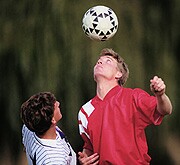
TUESDAY, Jan. 26 (HealthDay News) — Older kids who play soccer — which has one of the highest injury rates among youth sports — apparently are less apt to sustain a concussion from heading the ball than from hitting their head against another player or slamming their head into the ground, a new report says.
Ankle injuries are common among boys who play soccer, and knee injuries occur most often among girls. Overall, injury rates are especially high among pre-teen soccer players, the study authors noted.
Even so, said Dr. Chris G. Koutures, a pediatrician and sports medicine specialist in Anaheim Hills, Calif., and the report’s lead author, precautions can make a big difference.
“Soccer is a wonderful sport,” Koutures said. “It offers a lot of positive things to young players, and safer play can reduce injuries.”
The report, published in the February issue of Pediatrics, compiled recent research into youth-soccer injuries. Overall, Koutures said, the rise in injuries shown by earlier studies could be due to more aggressive play or to better reporting of injuries.
One of the more surprising findings may be the fact that hitting the ball with one’s head is not a major cause of concussions.
“Soccer has a comparable number of head injuries compared to football or ice hockey,” Koutures said. “But the head injuries were not from trying to head the ball, but head versus head, head versus elbow, head versus ground.”
That could be because, when a player heads the ball, “you’ve got your head, shoulder and neck muscles ready, you’re prepared for the jolt,” he said. Also, the ball is softer than, say, the ground.
Players younger than 10, though, appear to be at greater risk for injury from heading the ball, according to the report.
But another specialist warns that the jury is still out on one aspect of heading: subtle brain damage.
“The definitive studies haven’t yet been done,” said Dr. Karen Sheehan of Children’s Memorial Hospital’s Injury Prevention and Research Center in Chicago.
And it’s still not known if heading a soccer ball could cause long-term damage, said Dr. Robert S. Gotlin, director of orthopedic and sports rehabilitation at Beth Israel Medical Center in New York City.
As for the tendency for girls to hurt their knees and boys to injure their ankles, Koutures said that programs available online and elsewhere can teach players how to prevent particular injuries.
“Rather than dissuade them from playing, we want them to do things to help them reduce their risk,” he said.
In the big picture, Koutures said, “if you play long enough, there’s risk of some injury, but the majority of injuries keep the player off the field for less than a week.”
More information
The Nemours Foundation has more on youth sports injuries.

